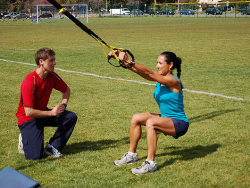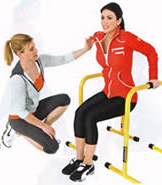Stocking a training business is cheaper than you think (puppy sold separately).
You’ve probably heard me refer to Personal Training as this really cool “loop-hole” for fitness enthusiasts. It’s a way to make excellent money and start a tremendous career doing what comes easy to you already, selling a product that doesn’t require any inventory, and only takes a handful of clients to achieve it.
Well that goes for the equipment you need to start a training business, whether it be a studio or on-location training practice. The truth is you can get started, stocked, and outfitted on a shoestring, and actually position that into a SELLING POINT.
That’s not pie-in-the-sky talk, “maybe-so” talk, or marketing talk. It’s how I’ve always trained, run a training business, and made big money from high-priced private to group sessions, and once you get some of the details, it’ll make sense to you too.
I know of a trainer out in New York who’s booked solid at $300 an hour who doesn’t use so much as a jump rope in his workouts, so yes, you can get started on the very, very cheap. And don’t worry, it won’t be looked at as an inferior way to train – if you frame it correctly, you can make it look like THE BEST way to train.
OUTFITTING A TRAINING STUDIO
I know it’s not just me that’s noticed Personal Training has gone very “minimalist” these days. You can learn this by looking around your local big-box chain gym. What you’ll find today is that the Personal Training areas of these gyms are usually separated from the rest of health-club. And what you’ll find in these training areas are very little traditional gym equipment. They have only the most basic equipment that can be bought for less then $200 out of a Perform Better catalog.
The lesson here is simple – people are paying premium rates to actually be separated from and NOT have access to any of the expensive gym equipment. In your own experience, you’ve probably found yourself taking your clients to a corner of the gym with a just a few dumbells so you could have some privacy. That underscores the fact that you don’t need a lot of equipment to deliver outstanding training sessions.
SAMPLE TOOLS
Even if you were to outfit a full, high-end training studio, you’d be surprised how little equipment you could get away with:

TRX uses gravity for resistance. Gravity is free.
TRX Suspension Trainer, a favorite of IDEA trainer of the year Nicki Anderson at her training studio, starts at only $150. All of Marc Lebert’s excellent products, from the Equalizer to the Buddy System, all cost at most $99. Your basic kettlebells vary in price from $15-$50. A complete rubberized dumbell set ranging in weight from five to twenty-five pounds will run you around $99. Resistance tubes – $5. Jump ropes – $2. You get the picture – you can fully outfit ever corner of a studio for about $500. And if you spend that much, your clients may be asking you why you have SO MUCH stuff.
HOME-GYM
This also works in your favor if you’re looking to start a home training studio. To explore that scenario, let’s look at this question from a reader of the blog and TLT owner:

Hi Kaiser, I just recently purchased your Top Level Trainer Manual. So much great info! Thank you so much! My question is: what is your opinion of the best priced and best quality home gym? I am newly certified and am planning on training at my home. Besides a home gym, what other equipment would you recommend purchasing? My funds are very limited right now; but have to start somewhere. – Kaye
For some reason, the idea of the home gym has always appealed to me. I think for certain personality types, with certain lifestyles and family responsibilities, being at home really works. It’s probably a type of home-based business that’s not looked at often, but for someone that love fitness, the potential is definitely there.
When you think of putting back the PERSONAL into Personal Training, it’s a very viable option – what’s more personal than having someone come to your house. Again, I think it’s only suitable for certain personality types, but if it’s something that will work for you and your lifestyle, go for it.
I’ve never done it, but I know of several trainers that do a very good job with it, including Lauren Brooks Miller. I also helped a former client start a thriving private practice out of his garage. He actually turned it into something amazing and very high end to tailor to the high end clientele in his area, and he hit it out of the park. Here’s how he did it:
He put rubber flooring on the floors, that can be purchased for about $500. He also had the walls lined in a very nice black wood surface – $500. He had a mural of the famous Charles Atlas ad painted on the well – it was amazing and very, very cool – $500. He had a bench and 250 pounds in weights that he got from CRAIGSLIST – $150. He got a BOWFLEX weight set – $350
A good piece of equipment for a studio or home-gym, but with the price tag, you could still certainly do without it.
As you can see, he went a little on the expensive side, with the total tab running up to over $2,000. If you’re starting from scratch, you might not have this much money to play with. The good news is you don’t have to go that far to create and outfit a space that serves your purposes nicely.
And the fact that he used CRAIGSLIST to acquire the most expensive equipment in his gym should be a lesson. I happen to know that Zach Even-Esch got a lot of his equipment from there, and saved a ton of money doing it.
What’s the take home lesson from all of this? That another benefit of training is that you can get started very inexpensively, and not have it looked at as a negative or inferior way to train in any way. It just takes some creativity, flair, and resourcefulness, but you can get everything you need to deliver high priced sessions, even on a shoestring budget.
————————————————————–
Want more info on some cool and UNCOMMON ways to train? Then check these out:
10/03/200 – Lauren Brooks Miller’s Personal Training Business
2/03/2009 – Wild Man Zach Even-Esch
7/31/2008 – On-Location Personal Training Explored
What do you think? Leave your comments below:

Kaiser,
A few years ago I took a sizable chunk of money that I came into and “invested” it in converting my garage into a neighborhood gym for me and a few buddies of mine. Most would likely call me nuts for what I poured into it, but since fitness is a passion of mine, and I am in it for the long haul, it seemed worthwhile to go top-end and buy stuff that would last a lifetime and beyond (somebody will be getting it when I am long gone). Plus since I had the funds and figured the best stuff would always retain a fair amount of resale value, I took the plunge.
Mind you this was purely for personal use and was not meant to be the start of a business………………….akin to a guy who spends a ton of coin souping up his own car but doesn’t plan on working in or starting a auto body of his own.
I will spare you a length list of all that I added, but I have a top of the line rack from Elite Fitness Systems, dumbbells from 5-120 pounds, barbells and plates (including bumper plates), a Nautilus functional Trainer, Atlantis low row, chest-supported row, GHR, and much more……………………..you can clearly see that I am out of my gourd (at least according to what most people would say about what I decided to go out and get). I chalk it up to being addicted to this stuff and being beyond fortunate to have had the funds to do it without thinking.
As of late, I’ve been thinking more and more about starting to train folks from home. While I have more than I would ever need to get the job done well, the garage still looks rough around the edges, since I didn’t do anything to spruce up the walls and such. So the equipment is top flight, but the overall look is anything but “professional.” Plus Winter time isn’t when most folks would want to train in there unless they are a bit crazy like me or have plenty of Under Armour Cold Gear handy. The hard cored environment and conditions mixed with high-end equipment could make for a unique selling point, but I’m also guessing that some might not take me seriously on account of the environment.
It would seem that I have no real barrier to potential success, seeing as how I already have an embarrassment of fitness riches at my disposal (in terms of equipment). Basically the point of this extremely long-winded post (thanks for bearing with me) is to ask if you see any reason why I can make the garage gym situation work given that I already have equipment covered and then some.
As always, thanks for sharing all of the great info that you do via this blog.
Hey Rob – welcome to the blog – yes you can definitely make it work – turn the negative into a plus – call it the “hardcore underground gym”, or “extreme training”, or something like that – you’re not starting a commercial facility, just a place that needs to keep only a few people happy at a time – get a nice logo, put it on the wall, paint a few matching colors, and that’s it – the way my former client turned trainer dealt with the heat issue in the winter is he had a space heater which he would turn on 30 minutes before his first session – this would get the room more than toasty – if your garage is bigger, then get two – GOOD LUCK man –
I got started for 76$. Bought two cheap Kettlebells from walmart and a few bands from IronWoody. Boom…instant portable training studio.
Started in home, got 3 clients fairly quickly THEN added a few more KB’s and some new bands and medicine balls. Sure, I add here and there, but honestly, I doubt I’ve paid out 500 after all these years.
In my home gym, where I train football players, I have tons of weights, bars, racks…and even there I slowly built, bought things from classifieds and craigslist and quickly built a hell of a gym.
If you’re new, just get creative. With a band, a kettlebell and bodyweight you can workout even the toughest among us.